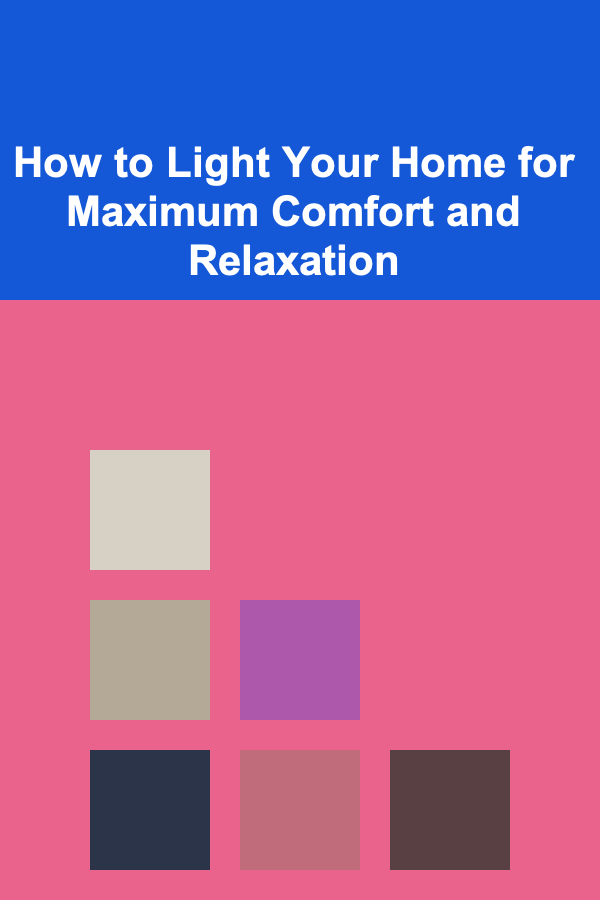
How to Light Your Home for Maximum Comfort and Relaxation
ebook include PDF & Audio bundle (Micro Guide)
$12.99$10.99
Limited Time Offer! Order within the next:

Lighting plays a crucial role in shaping the atmosphere of a space. It can influence mood, productivity, and overall well-being, making it essential for creating an environment conducive to comfort and relaxation. While lighting is often considered a functional element in interior design, its impact on the emotional and psychological comfort of a home cannot be overstated. This guide delves deep into how you can use lighting to maximize comfort and relaxation in your living spaces, from selecting the right types of lighting to strategically placing fixtures for optimal effect.
The Psychology of Lighting
Before diving into specific lighting strategies, it's essential to understand the psychological and physiological effects of light on the human body and mind. Light, or the lack thereof, affects our circadian rhythm, mood, and even stress levels. The brain associates different types of light with various emotional states and responses. For instance:
- Warm light is generally associated with calmness, comfort, and relaxation. It mimics the natural light during the evening and creates a cozy, inviting atmosphere.
- Cool light, on the other hand, tends to be invigorating and energizing, often associated with daylight hours. It can stimulate alertness and focus but can feel harsh when used in spaces intended for relaxation.
- Dim lighting helps the body prepare for rest and relaxation, signaling the brain that it's time to unwind.
- Bright, direct lighting often creates a more active, alert environment and is best used in work or task-oriented spaces.
By understanding these effects, you can make informed decisions about how to illuminate different rooms in your home to promote relaxation and well-being.
Types of Lighting
To achieve the perfect atmosphere in your home, it's important to incorporate a variety of lighting types. Different types of lighting serve different purposes and should be used in harmony to create a balanced and inviting environment.
Ambient Lighting
Ambient lighting is the foundation of your home's lighting scheme. It provides the overall illumination that allows you to move around your space safely and comfortably. Ambient lighting should fill the entire room without being overwhelming. For relaxation, the key is to keep ambient lighting soft and diffused. This can be achieved through:
- Ceiling lights: Consider dimmable overhead fixtures like chandeliers or flush-mount lights, which can provide broad coverage while allowing you to adjust the intensity.
- Recessed lighting: This creates a subtle, unobtrusive glow that fills the room evenly, ideal for living rooms and bedrooms.
- Lamps: Floor and table lamps offer soft, localized light and can be moved to various locations for added flexibility.
- Wall sconces: These can add a touch of elegance to your home while offering soft, ambient lighting that doesn't overwhelm the space.
When selecting ambient lighting for relaxation, choose fixtures that are dimmable or have soft diffusers to avoid harsh, glaring light.
Task Lighting
Task lighting is focused, direct lighting that enables specific activities, such as reading, cooking, or working. Although task lighting is essential in areas like kitchens, offices, and reading nooks, it should be carefully balanced with ambient lighting to avoid creating a harsh or stressful environment. For relaxation, you'll want to make sure your task lighting is adjustable and not overly bright or concentrated.
Examples of task lighting that work well for comfort and relaxation include:
- Reading lamps: A desk lamp or adjustable floor lamp can direct light where it's needed most without spilling over into other areas of the room.
- Under-cabinet lighting: In the kitchen, under-cabinet lights provide soft illumination for food preparation while keeping the ambient light low for a more relaxed atmosphere.
Task lighting is crucial for practical purposes, but it's essential to ensure it doesn't dominate your relaxation spaces.
Accent Lighting
Accent lighting is used to highlight specific features in your home, such as artwork, architectural details, or decorative plants. It creates visual interest and adds dimension to a room. In the context of relaxation, accent lighting can help create a serene ambiance by emphasizing certain elements in a subtle, non-intrusive way.
Types of accent lighting include:
- Spotlights and track lighting: These can be used to highlight art, sculptures, or architectural features. The focused beams add drama and warmth to the room.
- Candles: There's something inherently calming about the soft, flickering glow of a candle. Candles can be used strategically around your home to enhance relaxation, especially during the evening.
Accent lighting should never overpower the other forms of lighting in the room but should be used to complement the overall atmosphere.
Natural Lighting
Natural light is a powerful element in the home. It has numerous psychological benefits, from boosting mood to improving focus. When possible, you should design your lighting to take advantage of the sun's natural rays. Here are some ways to optimize natural light:
- Maximize window exposure: Use light, airy curtains or blinds that allow natural light to filter through during the day. Consider large windows or even skylights for rooms that could benefit from additional sunlight.
- Strategic placement of mirrors: Mirrors can reflect natural light deeper into the room, making spaces feel more expansive and bright.
- Reflective surfaces: Choose paint colors and decor with reflective finishes, such as light-colored walls or glossy furniture, which can amplify the effect of natural light.
It's important to be mindful of the natural light cycle and adjust your artificial lighting in response to changes in sunlight throughout the day.
Lighting in Different Rooms
Living Room
The living room is the heart of the home, often where people spend time together, relax, or entertain guests. For maximum comfort and relaxation, the living room needs a balance of ambient, task, and accent lighting. Here are some tips:
- Ambient lighting: Use dimmable ceiling lights or a combination of floor and table lamps to create a cozy, inviting glow. Avoid harsh overhead lights that can make the room feel sterile or uncomfortable.
- Task lighting: A reading lamp near seating areas can provide focused light for reading or other activities without overpowering the overall ambiance.
- Accent lighting: Highlight artwork or architectural features with subtle spotlights. Soft candlelight can also be used to create a calming, intimate atmosphere.
- Natural lighting: Keep window coverings minimal during the day to let sunlight in, and make use of mirrors to reflect that light deeper into the room.
The goal is to create an inviting, multi-layered environment that feels both cozy and spacious at the same time.
Bedroom
The bedroom is your sanctuary for rest and relaxation, and lighting plays a pivotal role in creating a peaceful environment. Soft, warm lighting can promote relaxation and signal to your body that it's time to wind down. Here's how to approach lighting in the bedroom:
- Ambient lighting: Use soft ceiling lights or pendant lamps with dimming capabilities. Overhead lighting should be gentle, avoiding harsh glare.
- Task lighting: Bedside lamps or wall-mounted reading lights allow you to read or perform tasks without disturbing the overall calm atmosphere. Ensure these lights are adjustable for flexibility.
- Accent lighting: Use string lights, candles, or soft wall sconces to create a relaxing glow. Dim lighting around the perimeter of the room can give the space a calm, enveloping feel.
- Natural lighting: If possible, incorporate windows that allow natural light to flood the room in the morning. Consider blackout curtains for better control over light levels at night.
The bedroom should be a place of tranquility, so prioritize lighting that encourages relaxation and restful sleep.
Kitchen and Dining Room
In the kitchen and dining areas, lighting should be functional but also relaxing. Here, task lighting will take precedence, but it should still contribute to an overall calm atmosphere:
- Task lighting: Overhead pendant lights or under-cabinet lighting can provide bright, focused light for cooking and food prep. Make sure these lights are dimmable to create a more relaxed atmosphere when not actively cooking.
- Ambient lighting: Install recessed lights or overhead fixtures to provide overall illumination without creating shadows or harsh glares.
- Accent lighting: Use accent lights to highlight your dining table or kitchen islands. Consider hanging pendant lights over the dining area for a cozy, inviting glow.
- Natural lighting: If your kitchen has windows, allow natural light to fill the space during the day. You can complement this with translucent blinds or curtains for privacy while still allowing light to filter through.
Lighting in the kitchen and dining room should create a balance between functionality and relaxation. After all, this is where you prepare and enjoy meals, so it's essential to have a welcoming atmosphere.
Bathroom
The bathroom is another room where lighting can significantly affect your mood and relaxation. Proper lighting can make a small space feel more spacious and serene, while poor lighting can make it feel cramped and uninviting. Here's how to achieve maximum comfort:
- Ambient lighting: Use soft ceiling lights or recessed lighting to create an overall glow. Avoid harsh, direct lighting that can feel too clinical.
- Task lighting: Install vanity lights around the mirror for tasks like shaving or applying makeup. Ensure the light is even and bright enough without being too intense.
- Accent lighting: Incorporate dim accent lighting or candles to create a relaxing, spa-like atmosphere. You might also use accent lighting to highlight artwork or decorative features in the bathroom.
- Natural lighting: If possible, use skylights or windows to allow natural light into the bathroom. Be mindful of privacy, especially in ground-floor bathrooms.
The key in the bathroom is balance --- creating enough light for functionality while maintaining a calm and soothing environment.
Conclusion
Lighting has the power to transform your home into a sanctuary of comfort and relaxation. By understanding the psychological effects of light and selecting the right types of lighting for each room, you can create a harmonious and inviting atmosphere. Whether you're enhancing the coziness of your living room, fostering restful sleep in the bedroom, or creating a spa-like ambiance in the bathroom, thoughtful lighting choices can improve your quality of life. Embrace the flexibility of lighting design, and you'll soon find that the right lighting is an essential ingredient in making your home the ultimate retreat for relaxation and comfort.
Reading More From Our Other Websites
- [Home Cleaning 101] How to Clean Your Grout and Tile Surfaces
- [Home Cleaning 101] Homemade Cleaning Solutions: DIY Recipes for a Cleaner Home
- [Toy Making Tip 101] Creative Toy Kits for Kids: How to Assemble and Gift Your Own Play Sets
- [Organization Tip 101] How to Create a Relaxing Spa-Like Atmosphere in Your Bathroom
- [Home Space Saving 101] How to Design a Multi-functional Guest Room: Incorporating Storage Benches and Wall-Mounted Solutions
- [Gardening 101] Top 10 Perennial Garden Flowers to Add to Your Garden
- [Personal Care Tips 101] How to Use Face Oil to Prevent and Treat Wrinkles
- [Home Holiday Decoration 101] How to Create a DIY Holiday Garland for Any Space
- [Scrapbooking Tip 101] DIY Scrapbook Templates: Transforming Basic Pages with Punch Techniques
- [Organization Tip 101] How to Organize Your Digital Life: Files and Folders

Criminology: Understanding Crime and Its Causes
Read More
How to Build a Checklist for Preparing for a Networking Event
Read More
How to Build a Strong LinkedIn Profile for B2B Dropshipping Success
Read More
How to Create Hidden Storage Under Your Stairs
Read More
10 Tips for Mastering the Art of Infused Spirits
Read More
How to Choose the Right Crystal for Your Zodiac Sign
Read MoreOther Products

Criminology: Understanding Crime and Its Causes
Read More
How to Build a Checklist for Preparing for a Networking Event
Read More
How to Build a Strong LinkedIn Profile for B2B Dropshipping Success
Read More
How to Create Hidden Storage Under Your Stairs
Read More
10 Tips for Mastering the Art of Infused Spirits
Read More